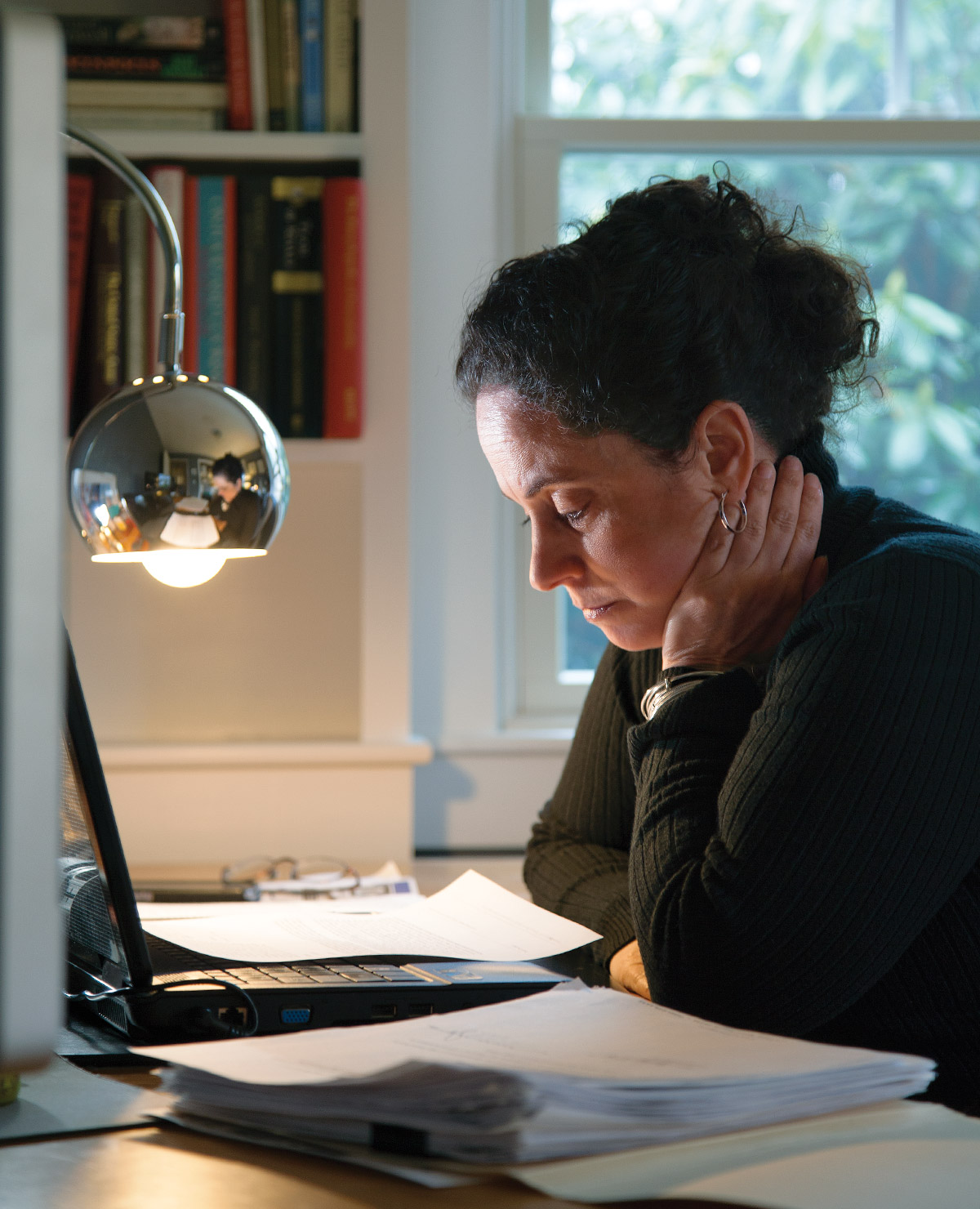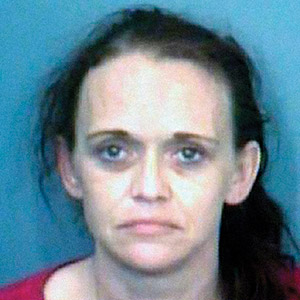Brian Peixoto’s Final Appeal

Lisa Munger spotted troubling discrepancies while reviewing Brian Peixoto’s trial records. / Photograph by Dana Smith
In 2010, Lisa Munger was hired to teach at the Department of Corrections. She had no experience working with prisoners, but one student quickly stood out. He’d been in prison for 14 years, and even though he was a high school dropout, the inmate had earned his graduation equivalency degree in 2000 and gone a long way in overcoming a learning disability. He was working toward a college degree in sociology from Boston University and spending nearly every day at the prison’s school department helping other inmates when Munger offered Peixoto a volunteer job coordinating a new tutoring program.
Armed with a sharp tongue and a nasal Massachusetts accent, Munger spent hours with Peixoto in the school department, sometimes just the two of them, and became his friend. Even though Munger had the ability to read about Peixoto’s case on her DOC computer, she didn’t—she had resolved to take her students as they were, without judgment or knowing what they’d done.
But one day, Peixoto told her anyway. “They say I killed a baby,” he explained, insisting—as he had for years—that he didn’t do it. After listening to Peixoto talk about the Ricki Lake show and his arrest, Munger wasn’t particularly moved. But her gut told her he was innocent. “I had already known enough about him to at least know that that wasn’t him,” she said. Touched by her faith in him, Peixoto’s heart melted. “It just made me feel like a human being,” he says.
Peixoto also told her about his ragtag efforts to overturn his conviction. During his first several years in prison, one attorney appealed over a relatively minor trial issue that the court chalked up to a “harmless error.” A second attorney had failed to file a federal appeal within the statute of limitations, barring Peixoto’s case from being heard.
As Munger and Peixoto grew closer, she began reviewing his trial records. She immediately spotted discrepancies and red flags, many of which had not been mentioned in previous appeals. She found it strange that there were no recordings of the police interviews in connection with Christopher’s death, and that state troopers waited to file their reports until after Peixoto had already been arrested. Munger also noted that investigators did not have Peixoto or Sneed sign sworn statements that their stories, written out by the cops, were accurate. But it was Sneed’s police interview the day of the autopsy—the one in which she changed her story and ultimately blamed Peixoto—that stunned her.

Though she did not implicate Peixoto at first, the dead boy’s mother, Ami Sneed, would testify against him at trial.
Seated in an interrogation room, Sneed was sticking to her original story—that Peixoto and she heard Tarisa cry for help and then rushed downstairs together—when a state trooper began tossing Polaroids of Christopher’s autopsy on the table in front of her. The poorly lit photos showed Sneed’s naked son, his eyes at half mast, his mouth slightly agape, splayed atop a blue tarp on an examining table. When Sneed instinctively pushed the first Polaroid away, the trooper moved it back in front of her. “You look at it,” he said. Then he dropped a second photo on the table, this one showing Christopher’s forehead appearing mottled by dark bruising. Sneed started crying, saying that she had never seen the bruises on his head before. Like a poker dealer, the trooper flipped over three more Polaroids. Again, he refused to let her look away. He said that Sneed’s story didn’t explain what the photos showed and demanded to know who’d done it. Sneed grew hysterical and was shaking uncontrollably. And that’s when her story, which had slowly begun to change throughout the interrogation, finally reached fruition. The bottom line, she declared, was that Peixoto had been downstairs alone with Christopher.
Asked about the interrogation, Sneed told me she originally did not tell detectives the truth about Peixoto’s whereabouts during Christopher’s death because she couldn’t believe that her boyfriend could be responsible for killing her son. But once she saw the Polaroids, she said, “it’s in my face and now I have no choice but to believe what happened, happened. Regardless of how I felt about that person, you did what you did and now it’s time for me to believe it.”
But to Munger’s untrained eye, it looked like old-fashioned witness intimidation. She had learned from other inmates about the existence of innocence programs, which sometimes provide prisoners with investigative and legal appeal services, and urged Peixoto to apply. He did. But with no DNA smoking gun to prove his case, the first innocence program he wrote to turned him down. “Hope is not a rock-solid thing,” Peixoto told me. “Hope erodes and it wears away until finally you wake up one day and you don’t even realize that you don’t have it anymore.”
Within a year or so of Peixoto’s going to prison, a seven-year-old playing on a set of monkey bars at school slipped and fell to the ground, injuring his forehead. He walked back inside the building without any help, but teachers called an ambulance. At the hospital, the child’s CT scan came back normal except for some bleeding between his scalp and skull. Doctors observed him overnight and released him the next morning. Two days later, the boy was doing homework when his grandmother noticed him stumbling and slurring his words. She rushed him back to the hospital, where another CT scan showed blood was not getting to parts of the boy’s brain. Three days later—five days after the initial fall—he died.
The boy’s case was one of 18 cited in a groundbreaking 2001 study published in The American Journal of Forensic Medicine and Pathology about fatal pediatric head injuries caused by so-called short-distance falls. At the time, many doctors believed that falls from 2 to 10 feet could not kill a child, and that a “lucid interval”—the time between a serious brain injury and the onset of symptoms—did not exist in an ultimately fatal head injury. The author of the study, John Plunkett, wrote that “more information is needed,” but he provided some of the earliest evidence that short falls can produce severe or fatal injuries in children with symptoms that mimic those associated with abusive head trauma. This was a seismic moment, and the ramifications of the change in medical understanding has had far-reaching implications for many people, including those serving prison sentences for allegedly killing children who died of natural or accidental causes. Since then, doctors have identified dozens of conditions, including certain illnesses, that can cause the same types of bleeding in the brain that were once considered clear indications of child abuse.
That wasn’t the only way science had evolved since Peixoto’s conviction. In 1996—the year Peixoto was arrested—it was common practice to determine the age of a bruise by its color. A guide distributed by the Department of Justice that same year included a chart matching the color of a bruise with its age. Both medical experts who testified against Peixoto relied on that method to date Christopher’s injuries. By 2014, however, medical opinions had changed drastically. The same DOJ guide, which previously provided a color chart, declared that determining the age of a bruise by its color was “no more accurate than chance.”
Perhaps the biggest changes concerning the science of child abuse have centered on so-called shaken-baby syndrome. As early as the 1960s, doctors believed that certain bleeding patterns and types of brain swelling definitively proved a child had been forcefully and intentionally shaken. But recent events have called into question the accuracy of numerous shaken-baby convictions, based in part on new understandings of brain science and new skepticism about the overzealous prosecution of shaken-baby cases. In December, the Middlesex County Medical Examiner’s Office reversed earlier findings of shaken-baby syndrome for the third time in just more than a year, resulting in accused baby killer Pallavi Macharla being released on bail. Arguably the most famous shaken-baby case took place in Newton, involving an eight-month-old boy and a teenage au pair from England named Louise Woodward.
Police arrested Woodward on charges of second-degree murder in 1997, one month before Peixoto’s trial, and accused her of shaking Matthew Eappen to death. Prosecutors relied heavily on testimony from medical and child-abuse experts, including Newberger, who testified at Peixoto’s trial. Newberger told the court that injuries to Eappen’s brain and skull could not have been inflicted accidentally, and that Woodward would have had to have violently shaken the baby for an extended period of time. As he did during Peixoto’s trial, Newberger also testified that the infant’s injuries were equivalent to his being tossed from a second-story window. After the jury convicted Woodward, the judge—in an extraordinary effort to avert what he called a “miscarriage of justice”—ruled that the evidence did not support the second-degree murder charge and reduced the sentence to time already served, allowing Woodward to return home.
The case later became synonymous with the tectonic shift in understanding about shaken-baby syndrome and child-abuse allegations. Thanks to new research about traumatic head injuries in children, Patrick Barnes—who testified for the prosecution along with Newberger—has since reversed his medical opinion. He now believes that Eappen’s injuries were likely inflicted accidentally, and that abuse is cited too frequently in lieu of alternative explanations, such as injuries from a previous fall. Newberger, however, had no such change of heart.
Meanwhile, as the aftershocks of Plunkett’s study reverberated in the medical and legal communities, other investigators were beginning to take a harder look at an underexamined yet crucial part of the diagnostic process: the autopsy. In June 2011, a joint Frontline-ProPublica investigation highlighted how flawed conclusions from child autopsies had led to wrongful arrests and convictions. Its main example was a Texas man named Ernie Lopez, sentenced to 60 years in prison after being accused of sexually assaulting and beating a six-month-old baby to death. During the trial, a medical examiner testified that the baby had died from blunt-force trauma. Now, medical experts believed the child’s injuries and death had resulted from complications related to a blood coagulation disorder, and that the baby had been sick for days.
Overall, the report sent up a series of red flags: Pediatric specialists were rarely, if ever, consulted on child autopsies, and medical examiners often failed to check the child’s past medical records, which could contain information relevant to their determinations. Many physicians were not board-certified in forensic pathology. In several cases, according to the report, “forensic pathologists worked so closely with authorities, they effectively became agents of law enforcement, rather than objective arbiters of scientific evidence.”
That summer, Peixoto stumbled upon the episode of Frontline. For 15 years, he had never thought to scrutinize the medical experts in his case who’d testified that Christopher had died immediately from injuries he’d sustained the day of his death. He knew he hadn’t harmed Christopher, but what really killed the child remained a mystery. As he watched the episode, he thought, That’s my case. That’s me.

